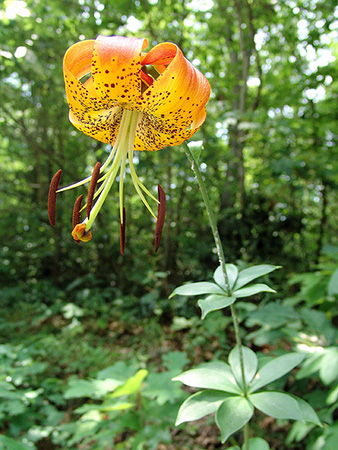State Wildflower of North Carolina: Carolina Lily
by Steven Case, 2007; Kelly Agan, 2016, Amy Kemp 2017
NC Government & Heritage Library
See also: North Carolina State Symbols and Official Adoptions main page
 In 2003, the General Assembly designated the Carolina Lily (Lilium michauxii) as the official State wildflower (Session Laws, 2003, c. 426).
In 2003, the General Assembly designated the Carolina Lily (Lilium michauxii) as the official State wildflower (Session Laws, 2003, c. 426).
Selection as State Wildflower
The bill to adopt the Carolina Lily as the State wildflower was sponsored by Rep. Rex Baker of Stokes County. Baker and his wife developed an affinity for the Carolina Lily when they rescued a cluster of the flower from being bulldozed in a road-widening project and transplanted them at their home. Baker spent two years trying to pass his bill, being postponed initially by the 2001 debate surrounding the adoption of the state fruit. In an effort to convince Governor Mike Easly of the merits of the Carolina Lily, Baker took a photograph of his own. Easley liked the photograph so much it hung in the Governor’s mansion for six weeks. The bill passed in the House of Representatives with a 111 to 7 vote and passed unanimously in the Senate.
Baker’s reasoning for the Carolina Lily as the state wildflower was that it is a beautiful flower that occurs throughout the state.
About the Carolina Lily
Named for Andre Michaux, a noted eighteenth century naturalist and explorer, this flower grows throughout the state, from the forests and hills of Cherokee County to the coastal swamplands (pocosins) of Hyde and Pamlico Counties. Michaux made a number of trips to North America, comissioned by the French government to study the continent's trees. Beginning in 1787, he made five trips to North Carolina from a base at Charleston, South Carolina. He made a number of important discoveries in the region.
The stem can grow up to 4 feet high, and can have up to 6 flowers at the summit, though 1-3 are more common. The petals are brilliant red-orange with brown spots, and arched back so that the tips overlap.
The Carolina Lily grows throughout the southeast, from West Virginia to Florida, and can bloom as late as October, though it is most prevalent in July and August. It is not endangered but it is rare, as the plants are slow growing and do not produce many seeds
North Carolina Session Laws
Here is the language specified in the legislation establishing the Carolina Lilly as the State Wildflower:
"Whereas, North Carolina is blessed with an abundance of wildflowers from the mountains to the coast; and
Whereas, the Carolina Lily is a scarce and beautiful flower that is found throughout North Carolina in upland pine-oak woods and pocosins; and
Whereas, the Carolina Lily (Lilium michauxii) is one of many plants named for the distinguished French botanist Andre Michaux who traveled widely in the southeastern United States; and
Whereas, Andre Michaux (1747-1802), a genuine hero of science and exploration, referred to the North Carolina mountains as "the great botanical laboratory and paradise of North America"; and
Whereas, the Carolina Lily, sometimes referred to as Michaux's Lily, bears up to six reddish-yellow, spotted flowers with petals that bend backwards; and
Whereas, each nodding flower grows to about three inches in diameter; and
Whereas, this magnificent flower bears the name of our great State; and
Whereas, the State of North Carolina does not have an official wildflower;"
References and additional resources:
Carolina Lily (USDA, NRCS. 2007. The PLANTS Database (http://plants.usda.gov, 18 June 2009). National Plant Data Center, Baton Rouge, LA 70874-4490 USA.)
Landis, Nomee. "Wildflower a rare find," Fayetteville Observer, The (NC), August 08, 2003.
"Legislative Briefs," The News & Observer, April 02, 2003: B5.
Image credit:
Sutherland, Zen. 2008. "Carolina Lily - Lilium michauxii." Online at https://www.flickr.com/photos/zen/2780380397/.
1 June 2007 | Agan, Kelly; Case, Steven; Kemp, Amy